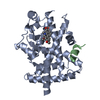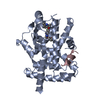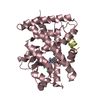Entry Database : PDB / ID : 4y29Title Identification of a novel PPARg ligand that regulates metabolism Peptide from Nuclear receptor coactivator 1 Peroxisome proliferator-activated receptor gamma Keywords / / / / / / / / / / / Function / homology Function Domain/homology Component
/ / / / / / / / / / / / / / / / / / / / / / / / / / / / / / / / / / / / / / / / / / / / / / / / / / / / / / / / / / / / / / / / / / / / / / / / / / / / / / / / / / / / / / / / / / / / / / / / / / / / / / / / / / / / / / / / / / / / / / / / / / / / / / / / / / / / / / / / / / / / / / / / / / / / / / / / / / / / / / / Biological species Homo sapiens (human)Method / / / Resolution : 1.98 Å Authors Wang, R. / Li, Y. Funding support Organization Grant number Country National Natural Science Foundation of China 31270776
Journal : Sci Rep / Year : 2015Title : Selective targeting of PPAR gamma by the natural product chelerythrine with a unique binding mode and improved antidiabetic potency.Authors : Zheng, W.L. / Qiu, L. / Wang, R. / Feng, X.H. / Han, Y.P. / Zhu, Y.L. / Chen, D.Z. / Liu, Y.J. / Jin, L.H. / Li, Y. History Deposition Feb 9, 2015 Deposition site / Processing site Revision 1.0 Sep 9, 2015 Provider / Type Revision 1.1 Nov 8, 2023 Group Data collection / Database references ... Data collection / Database references / Derived calculations / Refinement description Category chem_comp_atom / chem_comp_bond ... chem_comp_atom / chem_comp_bond / database_2 / pdbx_initial_refinement_model / pdbx_struct_oper_list Item / _database_2.pdbx_database_accession / _pdbx_struct_oper_list.symmetry_operation
Show all Show less
 Open data
Open data Basic information
Basic information Components
Components Keywords
Keywords Peroxisome proliferator-activated receptor gamma / NHR /
Peroxisome proliferator-activated receptor gamma / NHR /  nuclear receptor /
nuclear receptor /  coactivator /
coactivator /  Transcription factor / DNA BINDING PROTEIN-TRANSCRIPTION complex
Transcription factor / DNA BINDING PROTEIN-TRANSCRIPTION complex Function and homology information
Function and homology information prostaglandin receptor activity / regulation of cholesterol transporter activity / negative regulation of connective tissue replacement involved in inflammatory response wound healing / negative regulation of receptor signaling pathway via STAT / positive regulation of female receptivity / MECP2 regulates transcription factors / negative regulation of extracellular matrix assembly ...labyrinthine layer morphogenesis / regulation of thyroid hormone mediated signaling pathway / positive regulation of transcription from RNA polymerase II promoter by galactose /
prostaglandin receptor activity / regulation of cholesterol transporter activity / negative regulation of connective tissue replacement involved in inflammatory response wound healing / negative regulation of receptor signaling pathway via STAT / positive regulation of female receptivity / MECP2 regulates transcription factors / negative regulation of extracellular matrix assembly ...labyrinthine layer morphogenesis / regulation of thyroid hormone mediated signaling pathway / positive regulation of transcription from RNA polymerase II promoter by galactose /  prostaglandin receptor activity / regulation of cholesterol transporter activity / negative regulation of connective tissue replacement involved in inflammatory response wound healing / negative regulation of receptor signaling pathway via STAT / positive regulation of female receptivity / MECP2 regulates transcription factors / negative regulation of extracellular matrix assembly / negative regulation of vascular endothelial cell proliferation / negative regulation of cellular response to transforming growth factor beta stimulus / negative regulation of cardiac muscle hypertrophy in response to stress /
prostaglandin receptor activity / regulation of cholesterol transporter activity / negative regulation of connective tissue replacement involved in inflammatory response wound healing / negative regulation of receptor signaling pathway via STAT / positive regulation of female receptivity / MECP2 regulates transcription factors / negative regulation of extracellular matrix assembly / negative regulation of vascular endothelial cell proliferation / negative regulation of cellular response to transforming growth factor beta stimulus / negative regulation of cardiac muscle hypertrophy in response to stress /  arachidonic acid binding / positive regulation of low-density lipoprotein receptor activity / positive regulation of adiponectin secretion / lipoprotein transport / negative regulation of sequestering of triglyceride / positive regulation of vascular associated smooth muscle cell apoptotic process / hypothalamus development / macrophage derived foam cell differentiation /
arachidonic acid binding / positive regulation of low-density lipoprotein receptor activity / positive regulation of adiponectin secretion / lipoprotein transport / negative regulation of sequestering of triglyceride / positive regulation of vascular associated smooth muscle cell apoptotic process / hypothalamus development / macrophage derived foam cell differentiation /  DNA binding domain binding / male mating behavior / STAT family protein binding / positive regulation of fatty acid metabolic process / response to lipid / NR1H2 & NR1H3 regulate gene expression to control bile acid homeostasis / negative regulation of SMAD protein signal transduction / LBD domain binding / negative regulation of type II interferon-mediated signaling pathway / negative regulation of cholesterol storage /
DNA binding domain binding / male mating behavior / STAT family protein binding / positive regulation of fatty acid metabolic process / response to lipid / NR1H2 & NR1H3 regulate gene expression to control bile acid homeostasis / negative regulation of SMAD protein signal transduction / LBD domain binding / negative regulation of type II interferon-mediated signaling pathway / negative regulation of cholesterol storage /  E-box binding / alpha-actinin binding / negative regulation of blood vessel endothelial cell migration / lipid homeostasis / negative regulation of vascular associated smooth muscle cell proliferation /
E-box binding / alpha-actinin binding / negative regulation of blood vessel endothelial cell migration / lipid homeostasis / negative regulation of vascular associated smooth muscle cell proliferation /  R-SMAD binding / monocyte differentiation /
R-SMAD binding / monocyte differentiation /  estrous cycle / positive regulation of cholesterol efflux / cellular response to low-density lipoprotein particle stimulus / negative regulation of macrophage derived foam cell differentiation / negative regulation of lipid storage / cellular response to Thyroglobulin triiodothyronine / negative regulation of BMP signaling pathway / white fat cell differentiation / negative regulation of mitochondrial fission / Synthesis of bile acids and bile salts / positive regulation of fat cell differentiation / negative regulation of osteoblast differentiation / long-chain fatty acid transport / retinoic acid receptor signaling pathway / positive regulation of DNA binding /
estrous cycle / positive regulation of cholesterol efflux / cellular response to low-density lipoprotein particle stimulus / negative regulation of macrophage derived foam cell differentiation / negative regulation of lipid storage / cellular response to Thyroglobulin triiodothyronine / negative regulation of BMP signaling pathway / white fat cell differentiation / negative regulation of mitochondrial fission / Synthesis of bile acids and bile salts / positive regulation of fat cell differentiation / negative regulation of osteoblast differentiation / long-chain fatty acid transport / retinoic acid receptor signaling pathway / positive regulation of DNA binding /  cell fate commitment / Endogenous sterols / BMP signaling pathway / Synthesis of bile acids and bile salts via 27-hydroxycholesterol / Synthesis of bile acids and bile salts via 7alpha-hydroxycholesterol / nuclear retinoid X receptor binding / NR1H3 & NR1H2 regulate gene expression linked to cholesterol transport and efflux / response to retinoic acid / negative regulation of signaling receptor activity /
cell fate commitment / Endogenous sterols / BMP signaling pathway / Synthesis of bile acids and bile salts via 27-hydroxycholesterol / Synthesis of bile acids and bile salts via 7alpha-hydroxycholesterol / nuclear retinoid X receptor binding / NR1H3 & NR1H2 regulate gene expression linked to cholesterol transport and efflux / response to retinoic acid / negative regulation of signaling receptor activity /  histone acetyltransferase activity / Recycling of bile acids and salts / regulation of cellular response to insulin stimulus / cell maturation /
histone acetyltransferase activity / Recycling of bile acids and salts / regulation of cellular response to insulin stimulus / cell maturation /  histone acetyltransferase / cellular response to hormone stimulus / positive regulation of adipose tissue development / epithelial cell differentiation / peroxisome proliferator activated receptor signaling pathway / RORA activates gene expression / positive regulation of neuron differentiation /
histone acetyltransferase / cellular response to hormone stimulus / positive regulation of adipose tissue development / epithelial cell differentiation / peroxisome proliferator activated receptor signaling pathway / RORA activates gene expression / positive regulation of neuron differentiation /  lactation / Regulation of lipid metabolism by PPARalpha / cerebellum development / hormone-mediated signaling pathway / negative regulation of angiogenesis / response to nutrient / negative regulation of MAP kinase activity / fatty acid metabolic process / BMAL1:CLOCK,NPAS2 activates circadian gene expression / nuclear receptor coactivator activity / SUMOylation of transcription cofactors / Activation of gene expression by SREBF (SREBP) / negative regulation of miRNA transcription / response to progesterone / placenta development / Regulation of PTEN gene transcription / negative regulation of smooth muscle cell proliferation / nuclear estrogen receptor binding /
lactation / Regulation of lipid metabolism by PPARalpha / cerebellum development / hormone-mediated signaling pathway / negative regulation of angiogenesis / response to nutrient / negative regulation of MAP kinase activity / fatty acid metabolic process / BMAL1:CLOCK,NPAS2 activates circadian gene expression / nuclear receptor coactivator activity / SUMOylation of transcription cofactors / Activation of gene expression by SREBF (SREBP) / negative regulation of miRNA transcription / response to progesterone / placenta development / Regulation of PTEN gene transcription / negative regulation of smooth muscle cell proliferation / nuclear estrogen receptor binding /  transcription coregulator binding /
transcription coregulator binding /  nuclear receptor binding / hippocampus development / RNA polymerase II transcription regulatory region sequence-specific DNA binding /
nuclear receptor binding / hippocampus development / RNA polymerase II transcription regulatory region sequence-specific DNA binding /  peptide binding / negative regulation of transforming growth factor beta receptor signaling pathway / Heme signaling / SUMOylation of intracellular receptors / mRNA transcription by RNA polymerase II
peptide binding / negative regulation of transforming growth factor beta receptor signaling pathway / Heme signaling / SUMOylation of intracellular receptors / mRNA transcription by RNA polymerase II
 Homo sapiens (human)
Homo sapiens (human) X-RAY DIFFRACTION /
X-RAY DIFFRACTION /  SYNCHROTRON /
SYNCHROTRON /  MOLECULAR REPLACEMENT / Resolution: 1.98 Å
MOLECULAR REPLACEMENT / Resolution: 1.98 Å  Authors
Authors China, 1items
China, 1items  Citation
Citation Journal: Sci Rep / Year: 2015
Journal: Sci Rep / Year: 2015 Structure visualization
Structure visualization Molmil
Molmil Jmol/JSmol
Jmol/JSmol Downloads & links
Downloads & links Download
Download 4y29.cif.gz
4y29.cif.gz PDBx/mmCIF format
PDBx/mmCIF format pdb4y29.ent.gz
pdb4y29.ent.gz PDB format
PDB format 4y29.json.gz
4y29.json.gz PDBx/mmJSON format
PDBx/mmJSON format Other downloads
Other downloads https://data.pdbj.org/pub/pdb/validation_reports/y2/4y29
https://data.pdbj.org/pub/pdb/validation_reports/y2/4y29 ftp://data.pdbj.org/pub/pdb/validation_reports/y2/4y29
ftp://data.pdbj.org/pub/pdb/validation_reports/y2/4y29
 Links
Links Assembly
Assembly
 Components
Components / PPAR-gamma / Nuclear receptor subfamily 1 group C member 3
/ PPAR-gamma / Nuclear receptor subfamily 1 group C member 3
 Homo sapiens (human) / Gene: PPARG, NR1C3 / Plasmid: pET24 / Production host:
Homo sapiens (human) / Gene: PPARG, NR1C3 / Plasmid: pET24 / Production host: 
 Escherichia coli BL21(DE3) (bacteria) / Strain (production host): BL21(DE3) / References: UniProt: P37231
Escherichia coli BL21(DE3) (bacteria) / Strain (production host): BL21(DE3) / References: UniProt: P37231 / NCoA-1 / Class E basic helix-loop-helix protein 74 / bHLHe74 / Protein Hin-2 / RIP160 / Renal ...NCoA-1 / Class E basic helix-loop-helix protein 74 / bHLHe74 / Protein Hin-2 / RIP160 / Renal carcinoma antigen NY-REN-52 / Steroid receptor coactivator 1 / SRC-1
/ NCoA-1 / Class E basic helix-loop-helix protein 74 / bHLHe74 / Protein Hin-2 / RIP160 / Renal ...NCoA-1 / Class E basic helix-loop-helix protein 74 / bHLHe74 / Protein Hin-2 / RIP160 / Renal carcinoma antigen NY-REN-52 / Steroid receptor coactivator 1 / SRC-1
 Homo sapiens (human) / References: UniProt: Q15788
Homo sapiens (human) / References: UniProt: Q15788 Chelerythrine
Chelerythrine Water
Water X-RAY DIFFRACTION / Number of used crystals: 1
X-RAY DIFFRACTION / Number of used crystals: 1  Sample preparation
Sample preparation
 SYNCHROTRON / Site:
SYNCHROTRON / Site:  SSRF
SSRF  / Beamline: BL17U / Wavelength: 1.005 Å
/ Beamline: BL17U / Wavelength: 1.005 Å : 1.005 Å / Relative weight: 1
: 1.005 Å / Relative weight: 1  Processing
Processing :
:  MOLECULAR REPLACEMENT
MOLECULAR REPLACEMENT Movie
Movie Controller
Controller

















 PDBj
PDBj














